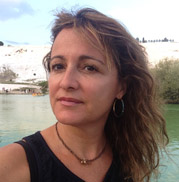 She was just four years of age when she developed meningococcal meningitis. Her parents called the paediatrician after Elena’s fever spiked.
She was just four years of age when she developed meningococcal meningitis. Her parents called the paediatrician after Elena’s fever spiked.
The doctor suspected it was measles but, when her symptoms worsened, he prescribed penicillin – a treatment for meningococcal meningitis – and advised her worried parents to bring Elena to hospital.
Learn more about different types of meningitis
“I was in hospital 24 hours after the first symptoms appeared. There, I developed stiffness of the neck which is a classic symptom of meningitis, and my parents began to see rashes on my skin,” she recalls.
A lumbar puncture confirmed her parents’ worse fears: meningitis.
“The doctor said we were very lucky – which sounds odd – but if it had been septicaemia the survival rates are much lower. Most children die within 24 hours of the first symptoms.”
Elena stayed in hospital for 10 days and was sent home with a clean bill of health. She had a lucky escape and no problems as a result of the infection.
But meningitis would make a second appearance in Elena’s life.
Many years later, having moved from France to Spain, Elena was tutoring a young girl who wanted to improve her grades. “Her name was Irene. She was 17-years-old and was very bright. She wanted to get As in her exams so I was helping her.”
One summer’s day, Elena had a visit from Irene’s parents. They told her that Irene had developed meningococcal septicaemia and died one day later. The disease Elena’s parents had been told they were lucky to have avoided had cost Irene her life.
- Arching of the back (infants)
- Behavioural changes
- Blank, staring expression
- Bulging fontanelle (infants)
- Cold hands and feet
- Diarrhoea
- Dislike of being handled (infants)
- Drowsy or difficult to wake
- Fever
- Irritability
- Listless, less responsive
- Loss of appetite, refusing food (infants)
- Muscle, leg or joint pain
- Neck retraction with arching of the back (infants)
- Pale or blotchy skin
- Rash or spots that don’t fade with pressure (also called purpure or petechiae)*
- Rapid breathing
- Seizures, fits or convulsions
- Sensitivity to light
- Severe headache
- Stiff neck
- Unusual high-pitched cry (infants)
- Vomiting
*Not everyone who contracts meningitis will get a rash. Don’t wait for a rash to appear before getting help.
The tragedy began a journey into patient advocacy which led Irene’s parents to found a patient organisation in Spain dedicated to raising awareness of meningitis. The organisation provides information about the disease, symptoms and vaccination.
“10 years ago there was nothing for patients and parents in Spain looking for information about meningitis. With advice from the Meningitis Research Fund in the UK, Irene’s parents decided to change that.”
The death of Irene, coupled with her own experience, inspired Elena to devote herself to the same cause. “This made me understand that I had a mission in the world,” she told Vaccines Today. “When you survive you have a mission.”
The organisation was very successful in Spain, putting the disease on the agenda like never before, and also hugely beneficial for people in Latin American where Spanish-language resources are much needed.
“We have an excellent relationship with the Ministry for Health. They trust us – everything that we publish is supervised by our scientific committee,” she says.
For Elena, her commitment to meningitis has earned her a new role at the Confederation of Meningitis Organisations (CoMO) where she is coordinator for Europe and Africa.
It’s a huge challenge, taking in a large and diverse geographical region which includes the so-called ‘Meningitis belt’ of sub-Saharan Africa where meningitis rates are very high and health services are often weak.
“The WHO is doing a great job spreading vaccination in all these countries where they are in the middle of a five-year plan to vaccinate all children in Africa against meningococcal A,” she explains.
The bacteria that cause most meningitis cases vary. In Europe, meningococcal serotype B causes 80% of cases. In Africa, the source of most cases is serotype A.
Vaccinating children against meningitis A in developing countries is a challenge. “The WHO depends on information from health officials but some countries do not have Ministers for Health or are not well organised,” Elena says.
CoMO’s goal is to continue to share information and raise awareness in Africa. “As a patient group we can help countries to inform their citizens about symptoms and about how to prevent the disease.”
It is a message that she and colleagues in patient organisations around the world are highlighting on World Meningitis Day, April 24th.
Meningitis Facts
- Meningitis can affect anyone, anywhere at any time
- Infants and children under five years old and adolescents between 15 and 19 years of age are most at risk.
- Meningitis kills or disables around 1.2 million people worldwide each year.
- Bacterial meningitis, which is the most severe and common form of meningitis, causes around 120,000 deaths globally every year.
- Even with prompt diagnosis and treatment, approximately 10% of patients will die within 24 to 48 hours after the onset of symptoms, and up to 20% or more will sustain permanent damage and disability.
- Cases are more frequent in developing countries due to poverty, overcrowding and lack of access to vaccines.
- Those surviving meningitis can have their lives devastated as a result of long-term effects, such as deafness, brain damage, learning difficulties, seizures, difficulties with physical activities and when septicaemia is involved loss of limbs.
- Many people don’t know the warning signs or that many types of meningitis are vaccine-preventable.
Source: Confederation of Meningitis Organisations (CoMO)




